
Paul Scott is Senior Director, Customer Experience Consulting, at Dimension Data. In this interview Paul weighs in on why and how contact centers need to catch up with the digital reality – or die.
Since the company was founded in 1983 in South Africa, Dimension Data has rapidly become a major global ICT solutions and services provider with clients in 58 countries and over 28,000 employees. We’ve been following Dimension Data since the end of the nineties as it became one of the leading voices in the call center, customer service and customer experience space. Its annual Global Contact Centre Benchmarking report, first published in 1997, is a must-read.
Go digital or die: it’s all about customer engagement and experience
Contact centers must go digital or die. It’s the introduction of the 2015 edition of Dimension Data’s annual contact center benchmarking report, the title of a Forrester report, a topic Forrester’s Kate Legget has been emphasizing across 2015 and the title of your recent keynote at the recent Customer Contact Expo 2015 in London. It’s hard to overlook the message. Why now? What’s different?
Paul Scott: For too many years, contact centres have been seen as a cost. Indeed it’s still almost 50%. The problem is customer engagement outside the contact centre is growing exponentially and in so many diverse ways, and traditional contact centres haven’t been able to keep up.
More enlightened companies, particularly the online ones have realised contact centres have to be integrated to stand a chance of delivering a consistently good customer experience. That means bringing together voice and digital agent assisted and self serve channels under one organisational structure.
Forward thinking organisations prioritise customer experience from the top down, appointing customer experience directors to coordinate customer experience initiatives and strategy across organisational silos
Start with the customer, understand the full picture and adopt customer analytics
I was digging through our archives and found back a 2009 report from the UK that showed contact centers supported more digital interaction channels than customers used them. An example: 3% of customers used SMS, 27% of contact centers supported it. Or social media: used by 4% of customers back then but supported by 20% of contact centers. Channel support as such is not the issue but information silos, lack of consistency, disconnected systems, poor processes and underequipped/unprepared staff/management are? Or anything else?
Paul Scott: I think back in 2009 a lot of contact centres were deploying new technology and channel capability without really knowing why or how they’d be used. Indeed, there are still organisations we know who are simply deploying web chat because they think it’s the right thing to do, with no real evidence of why, where and when.
It’s important to start with the customer and understand what they really need and want, but it’s equally important to look at the consequence of adding new digital channels. Quite often they can end up generating traffic in agent-assisted channels. We’ve seen this particularly in the Financial Services sector where poor web chat deployments actually increase voice calls rather than decrease them.
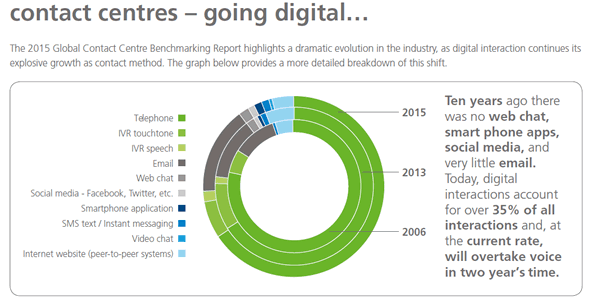
While many contact centers, help desks and customer service offer self-service options, it turns out that half of contact centers don’t use knowledge management. The result: poor FAQs and agents that don’t have access to the right information at the right time. Is knowledge management part of that ‘go digital or die’ message?
Paul Scott: It is, but analytics more so. A culture of adopting customer analytics across all channels and interaction types drives knowledge management in a positive way, increasing customer and staff engagement – the magic ingredients for improving loyalty and driving down cost.
Putting customer self-service in context
Back to self-service: it’s a key focus area for many years now. Again digging through my archives, I found that already in 2004 Yankee Group stated that contact centers back then were investing more in self-service platforms than in any other technology, including IVR. According to Forrester Research, for the first time ever the website (FAQs, self-help) has overtaken the phone as consumers’ primary channel for customer service in the US. Why has it taken so long you feel? And how have self-service and its role evolved?
Paul Scott: Customer’s appetite for self-serve has increased tenfold in the last 10 years. The adoption of smart phone devices, better internet speeds, the proliferation of smart phone apps, communities and special interest groups has fuelled self service to all time highs. But there is consequence.
The more we seek self service, the more the propensity for generating higher complexity more emotionally charged calls. This means by the time a customer reluctantly calls a call centre, they’ve exhausted all other options and demand an answer to their query. Agents need to be intelligent, articulate and able to think on their feet. The calls are longer and the need for first contact resolution far higher. It’s like a self-service tax. The more we demand self service, the more we need to arm our call centre agents with the ability to handle more complex calls.
A deeper dive into analytics, customer experience and metrics
Dimension Data’s latest benchmarking report also emphasized that customer experience has become the number one strategic performance measure for contact centers. That brings me to measurements and analytics, a topic you just mentioned. The report found that analytics will be key in the next 5 years, but 40% have no capability. What do you think is missing/needed?
Paul Scott: This is to do with customer analytics. Call centres have been undertaking analytics for years: calls, agent and team performance. We’ve analysed contact centres to death. But bizarrely there’s been very little customer analytics beyond understanding call types and satisfaction levels.
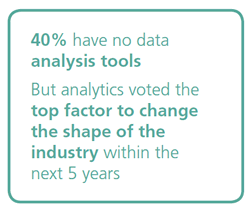
Our colleagues in the digital world thrive and survive on customer analytics. They track every click through, page view and mouse movement. They make decisions on customer journeys for example, based on what a customer does rather than what they say they will do. Why? Because they have hard data rather than perceptions and opinions. Contact centres need to adopt the tools and disciplines of their digital colleagues. It’s the dawn of a new age in customer engagement analytics and the call centre needs to play a central role in this.
How should contact centers proceed in order to really improve and gauge customer experience? As the contact center doesn’t or shouldn’t live in isolation what about these improvements and measurements regarding customer experience in an end-to-end way across the business?
Paul Scott: Customer experience is never simply the concern of the contact centre. In fact it’s the responsibility of the whole organisation. Forward thinking organisations prioritise customer experience from the top down, appointing customer experience directors to coordinate customer experience initiatives and strategy across organisational silos.
Linking customer experience to brand values and establishing some guiding principles, which everyone can understand and buy into, is critical. Surprisingly few organisations do this yet, but it’s becoming an imperative.
In line with the previous questions. Forrester’s Ian Jacbos says that contact center and customer service metrics must support broader company KPIs. Where do you get started?
Paul Scott: The easiest place to start is with Net Promoter Score (NPS). The reason being it applies to all channels, voice, digital and physical and all customer touch points in sales, marketing and service. It’s a universally recognised measure, making it easy to benchmark and most importantly it’s a proper closed loop process, which promotes continual improvement.
Of course there are other measures such as Customer Effort Score and simple Csat (editor’s note: customer satisfaction), but for my money, if you wanted to make a tangible impact in as short a time as possible, NPS is a great place to start. It drives the right kind of cultural behaviours and it delivers actionable outcomes.
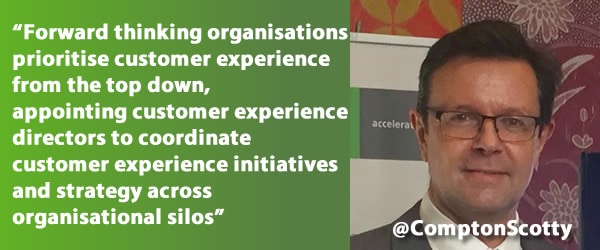
Digital evolutions: weighing in on the agent, social and technology
For contact centers it’s digital or die. While supporting digital channels and automating lower value processes is essential, the human interaction, for instance when self-service doesn’t help, remains crucial. How do you see the role of the contact center agent evolving? What do they need to succeed in serving this ‘digital customer’, whether it concerns changes in the way they’re trained, how they are managed and ‘measured’, get access to information, work etc?.
Paul Scott: Just about everything has changed for the digitally enabled agents of today. Not every agent competent in voice is suited to digital service. The cognitive ability and emotional quotient of agents handling digital and voice interactions is higher today than it was say five years ago. Their managers need to be better coaches and focused on real-time interventions rather the periodic reviews.
The whole environment is a lot more dynamic and changes need to be made on the fly. It’s actually a far more rewarding place to work than the traditional calls-only environment.
We see more and more artificial intelligence techniques popping up in the contact center. Think for instance about the knowledge base, semantic analysis, text analytics, sentiment etc. Is it the future to enhance customer experience, solve the knowledge management issue and enable agents to focus on exceptions and a role as customer experience value creators?
Paul Scott: New technology along the lines of the tools you’ve highlighted is exciting and certainly has huge potential. The challenge for organisations is to get beyond the hype and make sure the new tech they deploy is relevant, has clearly defined outcomes and can be adapted quickly to meet changing customer needs. Our industry is littered with examples of organisations that’ve adopted new tech too quickly and without clear boundaries. My advice? Beware the vendor promising something that sounds too good to be true – it probably is. Articulate requirements based on customer and business requirements and avoid over promising.
Social media is picking up as well. Social customer care has been siloed or put in the hands of social media teams for quite some time (if done at all). Do you see evolutions regarding the integration within the contact center? I guess there is no one size fits all way to connect both better?
Paul Scott: We’ve seen from this year’s report social media service is becoming much more common in the contact centre, which can only be a good thing. The important thing is to recognise it’s a cog in a very big wheel. Its not a channel owned by the business, it’s owned by customers and that means adopting an approach that recognises that fact.
Some of the disciplines in traditional customer service have a role to play in social media and as we understand better the dynamics of social media it will become more mainstream in contact centres.
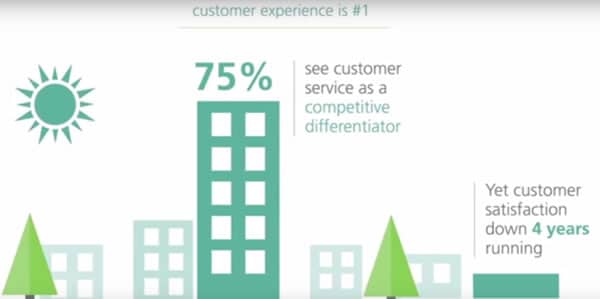
Three urgent calls-to-action for contact center managers
If you would have to summarize the key findings from your latest annual contact center benchmarking report and pick the – according to you – 3 most pressing calls-to-action contact center managers should start working on right now, what would they be?
- Develop your digital channel integration strategy and start work today!
- Work out how you’re going to have IT support the creation of an omnichannel strategy, delivering a joined up customer experience and commit to some milestones; short, medium and long terms.
- Define how customer analytics needs to be deployed in your customer engagement environment and start engaging people who can help you source the tools and processes needed to demonstrate the value your contact centre truly delivers.
In debate: views on contact center views
I’ve been asking you a bunch of questions and am grateful for the time you dedicated replying to them. Let’s end with a few quotes. If you could comment on them?
“Happy people sell. Miserable bastards don’t” (your fellow Customer Contact Expo speaker Nev Wilshire).
Paul Scott: Nothing works properly in customer contact centres unless there is proper staff engagement. Fact.
“Several metrics today rely on simply asking customers or agents about their experiences. Customer effort, Net Promoter Scores (NPS), and basic customer satisfaction scores are typically collected in this manner. However, often these explicit measures do not give companies actionable information on the specific sources of friction that cause higher effort, or drive down satisfaction or NPS”. (Forrester’s Ian Jacobs)
Paul Scott: Not true. If NPS is implemented properly it absolutely does deliver actionable information and drives loyalty. If you need evidence, come and see me!
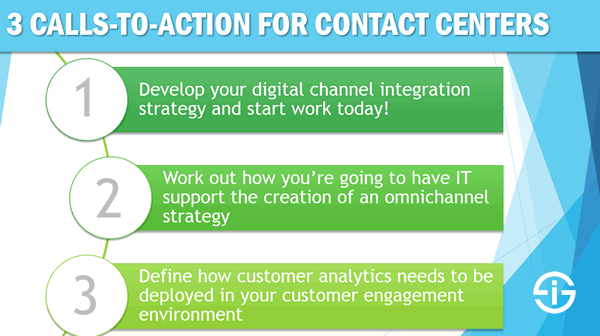
The telephone will remain, but as part of a much broader mix of options. It will be used more as an escalation channel, as contact centers evolve from being telephone-centric stereotypes into customer resolution centers. (Your colleague Adam Foster in a blog post announcing the 2015 benchmarking report).
Paul Scott: The call phone is the moment of truth. Assume by the time the customer calls, they’ve exhausted all other channels.
Calling the call center of a big company today feels pretty similar to what it felt like in the 1980s. In my view, the thing that’s lagging for today’s contact centers isn’t actually the technology, it’s the people and how they’re managed. (Matthew Dixon, keynote speaker at the expo in our recent interview).
Paul Scott: I agree most of the dysfunction in contact centres is down to the way they are managed and run. Working practices have changed far to slowly.
Oftentimes, the root cause driver of why a customer bails out of self-service is because they are overwhelmed by the number of choices and options presented. In other words, the company has put too much technology in front of customers. (again Matthew Dixon, keynote at the expo in our recent interview).
Paul Scott: If he’s referring to poorly designed IVR’s, I agree. It’s probably the worst deployed technology of the 20th and 21st century. When will we learn – start with the customer, put yourself in their shoes and experience what they do. You’ll soon learn what needs to change!
“Easy” is emerging as the big one for me. We know that 88% of customers who find it easy to do business with an organization will come back again. (BT’s Nicola Millard, also a speaker at the conference, in a previous interview).
Paul Scott: It’s kind of stating the obvious isn’t it? We all want it to be easy, but in most cases that’s only because we need service at all. Organisations need to get better at pre-empting customers with proactive customer service. This is the new frontier for customer engagement: predicting what customers need before they even realise they need it – thus negating a call altogether.
Contact centers don’t take care of the basics to deliver quality care. (Forrester’s Kate Leggett).
Paul Scott: If she’s referring to what they measure and manage, then I’d agree. There is too much of an obsession on quality monitoring and its often monitoring the wrong things. Try measuring three drivers for satisfaction and three for dissatisfaction rather than forty things on a QA tick sheet.
Thanks Paul Scott. Quite some food for thought and actionable takeaways. If you want more, check out the page of Dimension Data’s annual report (you can download a free summary of the latest benchmark).
You can also read more about ‘the digital must in the contact center on the blog of Dimension Data as in this recent piece by Chris Nunn, referring to this Year’s Customer Contact Expo and how “it’s all about a completely integrated and responsive customer experience”.
Dimension Data’s 2015 Global Contact Centre Benchmarking Report, © Dimension Data 2009-2015.

